90 years after Prohibition ended, here's the most popular alcohol in each state
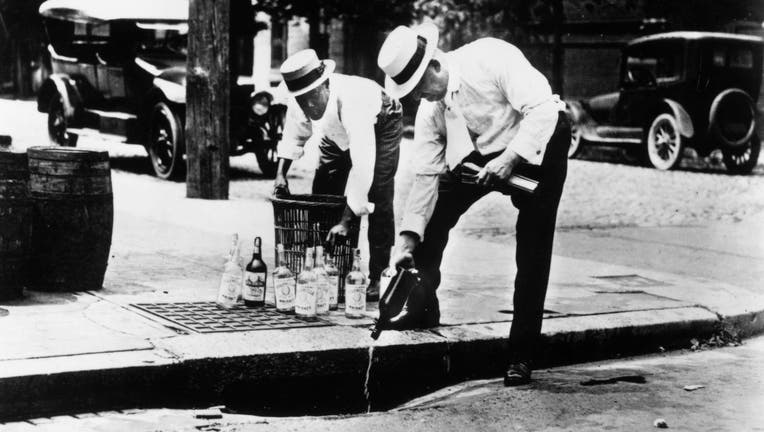
circa 1920: Two men pouring alcohol down a drain during prohibition in America. (Photo by Hulton Archive/Getty Images)
Tuesday marks 90 years since the end of Prohibition, the 13-year federal ban on alcohol now largely viewed as a failed experiment that glamorized illegal drinking.
The Prohibition Era lasted from Jan. 17, 1920, until December 1933, but many states had their own prohibition laws before it became illegal nationwide. During Prohibition, deaths from alcohol-related cirrhosis declined, as did arrests for public drunkenness. But the ban on booze had many unintended social and economic consequences that eventually led to its demise.
Here’s the history of Prohibition, and 90 years after its end, a look at the most popular alcohol in each state.
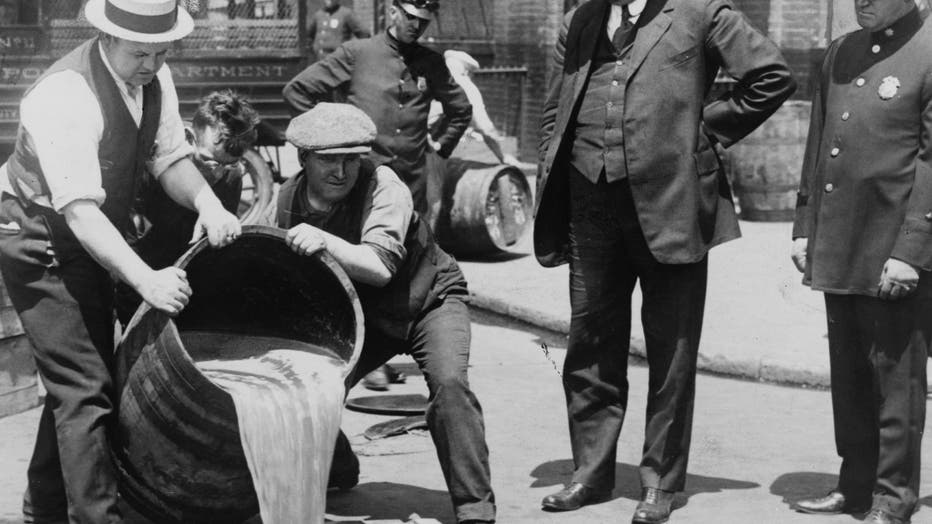
Agents pour liquor into sewer in NYC following a raid during the height of prohibition (Photo by Buyenlarge/Getty Images)
How did Prohibition begin?
Ratification of the 18th Amendment in 1919, which set the stage for Prohibition’s launch a year later, culminated a century of advocacy by the temperance movement. Leading forces included the Women’s Christian Temperance Union, the Anti-Saloon League and many Protestant denominations. Prohibition supporters assailed the impact of booze on families and the prominent role that saloons played in immigrant communities.
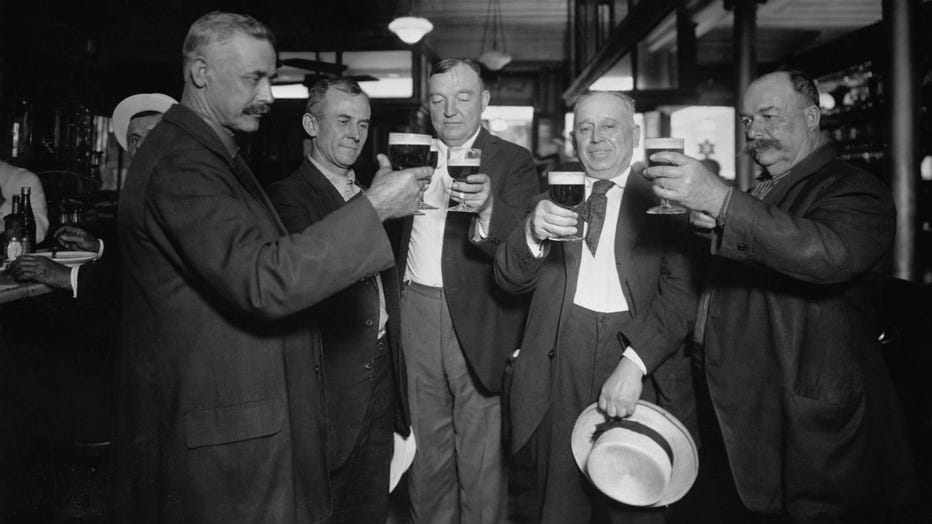
A group of men enjoys a last evening of drinking before Prohibition outlaws their pastime. (Getty Images)
By the time the constitutional amendment was ratified in January 1919, many states had enacted their own prohibition laws. That October, Congress passed a law detailing how the federal government would enforce Prohibition. It was known as the Volstead Act in recognition of its foremost champion, Rep. Andrew Volstead of Minnesota. The law banned the manufacture, sale and transport of any "intoxicating liquor" — beverages with an alcohol content of more than 0.5%, including beer and wine.
What were the unintended consequences of Prohibition?
Prohibition’s start in 1920 coincided with a major expansion of the Ku Klux Klan, which supported the ban on alcohol as it waged its anti-immigrant, anti-Catholic and racist activities.
READ MORE: Moderate alcohol consumption has no health benefits, analysis finds
The Volstead Act "provided a way for the Klan to legitimize its 100% Americanist mission — it could target the drinking of those they perceived to be their enemies," said Harvard history professor Lisa McGirr, whose 2015 book "The War on Alcohol" examines Prohibition’s political and social repercussions.
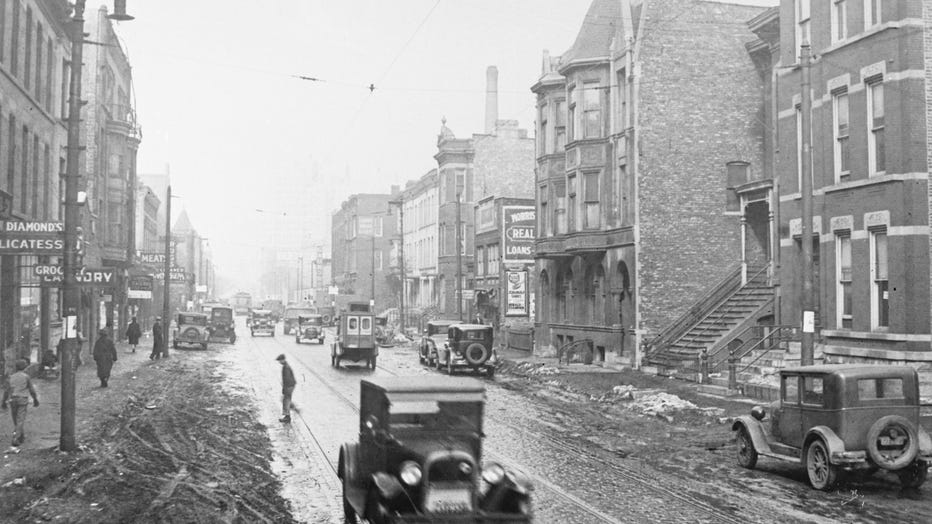
Gangsters hideout across from St. Valentine's Day Massacre slaying scene in Chicago, Illinois. (Getty Images)
One notorious example occurred in 1923-24 in southern Illinois’ Williamson County, where the Klan mobilized hundreds of volunteers to raid saloons and roadhouses. Hundreds of people were arrested and more than a dozen killed.
It’s simplistic to say Prohibition created organized crime in America, but it fueled a huge expansion as local crime gangs collaborated with those from other regions to establish shipping systems and set prices for bootlegged alcohol. Beneficiaries included Chicago-based gangster Al Capone, who earned tens of millions of dollars annually from bootlegging and speakeasies. In the infamous St. Valentine’s Day Massacre of 1929, gunmen disguised as police officers killed seven men from a gang that sought to compete with Capone’s empire.
MORE: Emmitt Smith partners with Bud Light for new NFL campaign, talks why fans should come back to brand
Beyond the ranks of gangsters, legions of Americans were committing or abetting crime. Michael Lerner, in his book "Dry Manhattan: Prohibition in New York City," says courtrooms and jails were so overwhelmed that judges began accepting plea bargains, "making it a common practice in American jurisprudence for the first time."
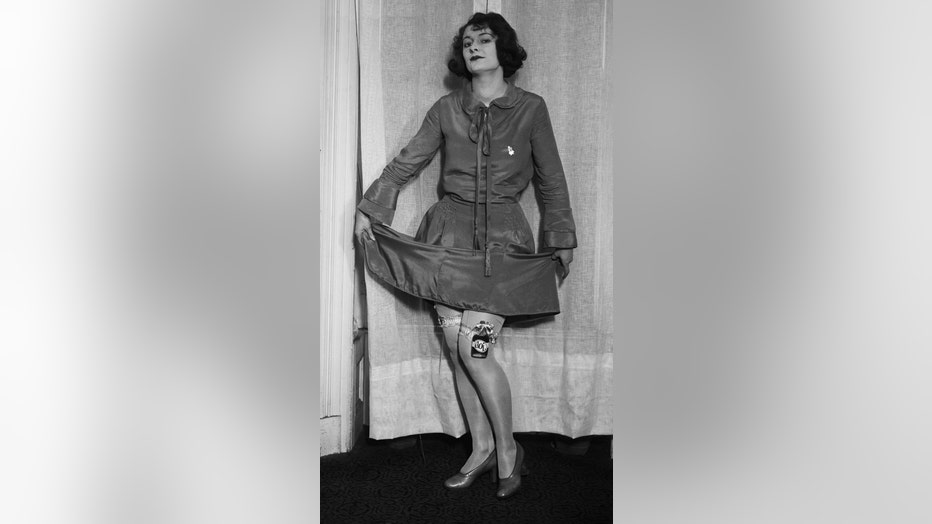
ORIGINAL CAPTION 1/14/1926-Miss Agnes O'Laughlin wearing her new initialed garter flask which has become the latest rage. Dozens of small 3-drink containers have been sold to fashionable young ladies. They promise to upset the purpose of the search a
Anti-immigrant sentiment was a key factor behind Prohibition, partly because of record-high immigration in the preceding decades. The era offers a poignant history lesson on how the restrictions targeted Blacks and recent immigrants more harshly than other communities. That treatment eventually propelled many of those marginalized Americans into the Democratic Party, which engineered Prohibition’s repeal.
"Prohibition had a lot of unintended consequences that backfired on the people who worked so hard to establish the law," McGirr said.
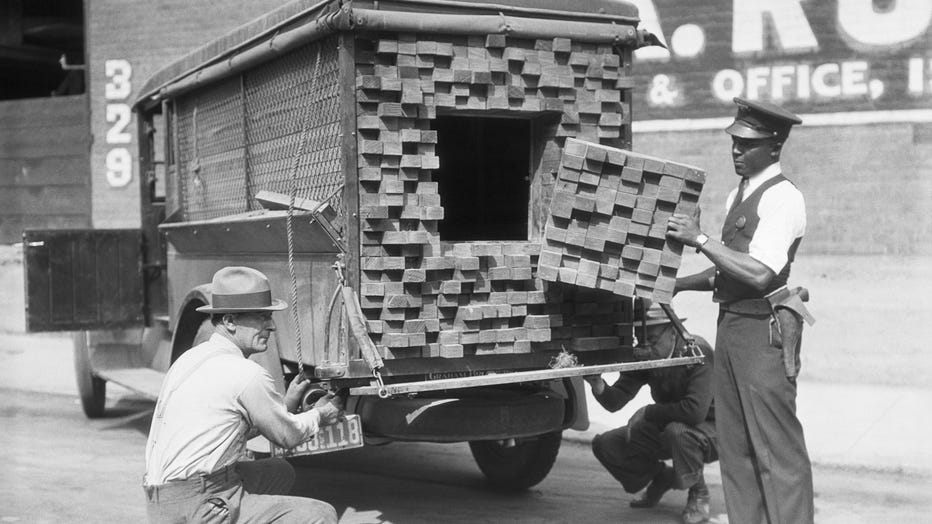
ORIGINAL CAPTION 10/23/1926-What appeared to be an innocent truckload of lumber, turned out to be a bootlegger's vehicle loaded with prime scotch when the Los Angeles Federal Prohibition Agents smelled the odor of a broken bottle. Investigation discl
"It helped to activate and enfranchise men and women who had not been part of the political process earlier," she said. "That was not the intention of Prohibition supporters."
Why did Prohibition end?
The social friction and violence caused by the KKK and organized crime gangs helped spur efforts to repeal Prohibition. Economics also played a role.
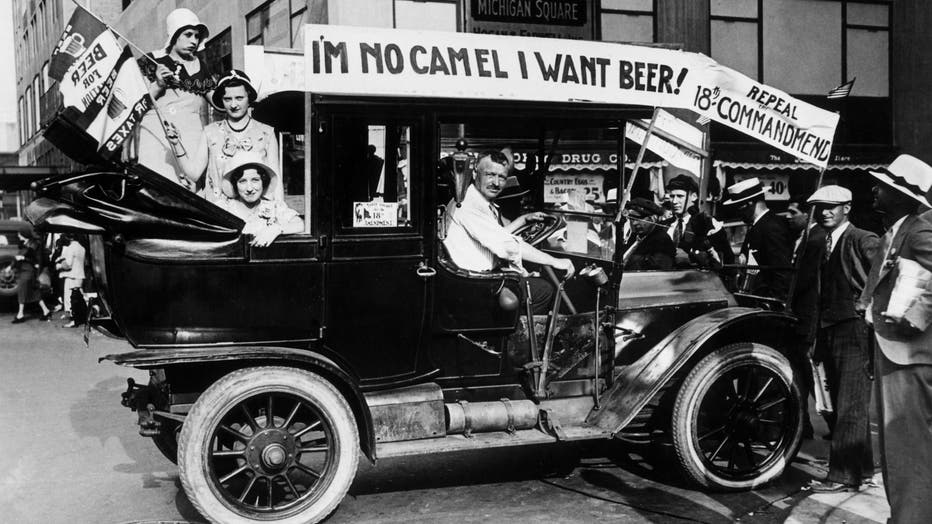
Prohibition protesters parade in a car emblazoned with signs and flags calling for the repeal of the 18th Amendment. One sign reads, 'I'M NO CAMEL I WANT BEER!' (Photo by Archive Photos/Getty Images)
While some Prohibition supporters predicted it would boost the economy, instead it proved harmful. Thousands of jobs were lost due to closures of distilleries, breweries and saloons. Federal, state and local governments lost billions in revenue as liquor taxes disappeared. One major consequence: Increasing reliance on income taxes to sustain government spending.
MORE: Drinking alcohol could increase risk of more than 60 diseases, study suggests
The onset of the Great Depression hastened Prohibition’s demise, as the need for more jobs and tax revenue became acute. The Democratic Party called for repeal of Prohibition in its 1932 platform; its presidential nominee, Franklin D. Roosevelt, embraced that cause as he rolled to a landslide victory over incumbent Republican Herbert Hoover.
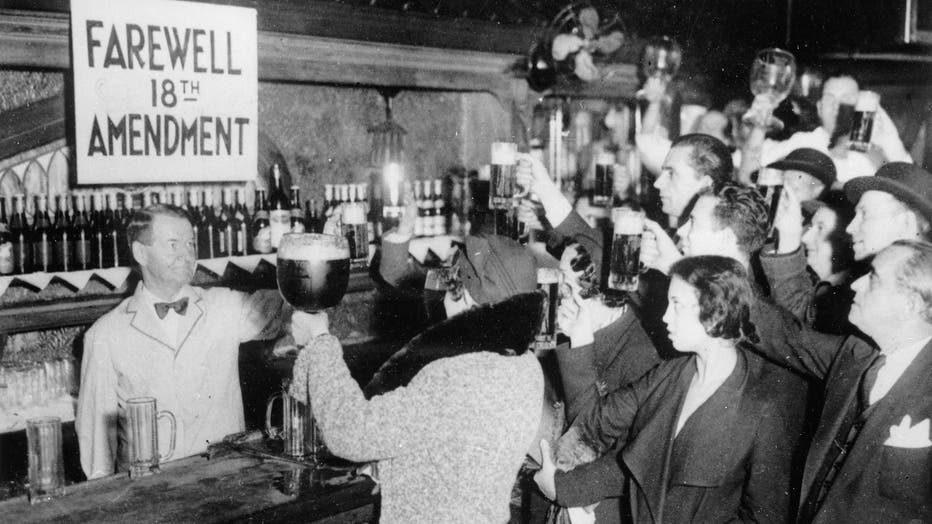
1933: People of New York are celebrating the end of the Prohibition with beer. Photograpg. 1933. (Photo by Imagno/Getty Images)
In March 1933, soon after taking office, Roosevelt signed a law legalizing the sale of wine and 3.2% beer. Congress also proposed a 21st Amendment that would repeal the 18th Amendment. Prohibition formally ended that December, when Utah provided the final vote needed to ratify the new amendment.
Most popular alcohol in your state
A hundred years after Prohibition began in 1920, Americans were drinking more in early 2020 than they were before alcohol was banned. Consumption rose even more in 2020 and 2021 amid lockdowns and the COVID-19 pandemic.
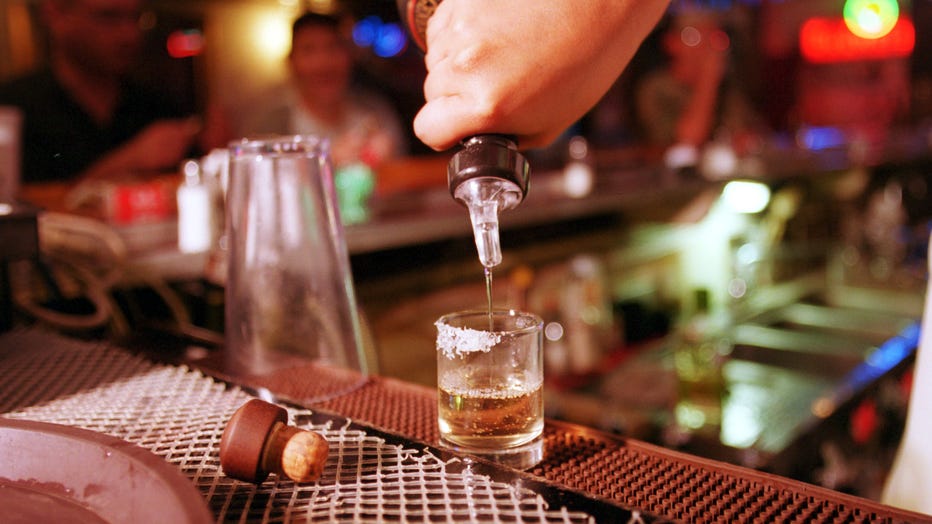
A shot of tequila. Tequila is the most popular type of alcohol in two states. (Photo by Joe Raedle/Newsmakers)
Today, Americans are drinking as much now as they did just before the start of the Civil War, according to federal government data analyzed by The Hill.
Last year, travel company Upgraded Points used Google Trends data to determine the most popular kinds of alcohol in each state, along with favorite celebrity-brand boozes.
MORE: Get red wine headaches? New research offers explanation
Their analysis found whiskey is the most popular type of liquor in most states, but vodka is a close second.
"Staple liquors like tequila and rum aren’t the most popular liquor in nearly as many states, so the gap between whiskey and vodka and the other liquors is quite large," analysts said.
According to Upgraded Points, here’s the most popular kind of alcohol in each state:
- Alabama: Whiskey
- Alaska: Scotch
- Arizona: Tequila
- Arkansas: Whiskey
- California: Tequila
- Colorado: Whiskey
- Connecticut: Vodka
- Delaware: Vodka
- Florida: Vodka
- Georgia: Cognac
- Hawaii: Rum
- Idaho: Vodka
- Illinois: Whiskey
- Indiana: Whiskey
- Iowa: Whiskey
- Kansas: Scotch
- Kentucky: Bourbon
- Louisiana: Cognac
- Maine: Vodka
- Maryland: Cognac
- Massachusetts: Vodka
- Michigan: Whiskey
- Minnesota: Vodka
- Mississippi: Cognac
- Missouri: Whiskey
- Montana: Whiskey
- Nebraska: Whiskey
- Nevada: Absinthe
- New Hampshire: Vodka
- New Jersey: Vodka
- New Mexico: Tequila
- New York: Vodka
- North Carolina: Vodka
- North Dakota: Vodka
- Ohio: Vodka
- Oklahoma: Whiskey
- Oregon: Whiskey
- Pennsylvania: Vodka
- Rhode Island: Vodka
- South Carolina: Whiskey
- South Dakota: Whiskey
- Tennessee: Whiskey
- Texas: Tequila
- Utah: Vermouth
- Vermont: Scotch
- Virginia: Scotch
- Washington: Whiskey
- Washington, D.C.: Gin
- Wisconsin: Brandy
- Wyoming; Whiskey
The Associated Press contributed to this report.

